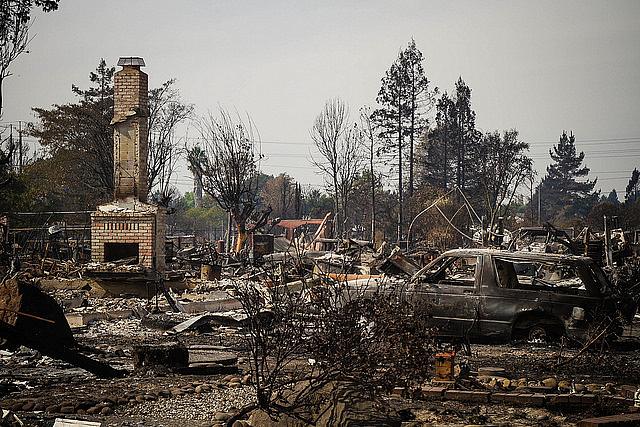California’s kids face long-term health consequences from devastating wildfires

Damage from the Tubbs Fire in Santa Rosa's Coffey Park.
Credit: California National Guard
On the night of October 8, 2017, three wildfires swept through the North Bay in the middle of the night. The Tubbs, Nuns and Pocket Fires destroyed over three thousand homes, leveling neighborhoods and claiming 42 lives.
I met 15-year-old Isabella Terrazas at the one-year anniversary vigil for Tubbs Fire survivors. She was sitting in the middle of the square, in downtown Santa Rosa, writing messages of hope in chalk with her mom, brother and sister. Her family’s home was one of thousands that burned down in the fire.
The night it burned they were celebrating her mom’s birthday. Not long after the guests left, they smelled smoke and saw an orange glow on the hillside. They left as quickly as they could — the only thing Isabella got out with were the clothes on her back, her cell phone and a pack of playing cards.
At the time the Tubbs Fire hit Santa Rosa, it was the most destructive in California history. It has since been surpassed by the Camp Fire in Butte county, which destroyed over 7,000 homes and killed 88 people.
Over a year later, families are still struggling from both the initial trauma and the aftermath of these fires. Terrazas’ family has still not found a place to live and she has been staying with a friend from school for over a year. The trauma has been difficult for her to process, “I still don’t know how I feel yet,” she said.
According to the U.S. Centers for Disease Control and Prevention, adverse childhood experiences (ACEs) can lead to poor health outcomes later in life. The greater the number of ACEs a child endures, the more likely they will be to suffer from health conditions like asthma, diabetes, coronary heart disease and others. During natural disasters like wildfires, traumatic events are often compounded. This includes community-wide disruptions, loss of loved ones, displacement, and the ongoing stress of living in the same geographic area where the event is likely to happen again.
Terrazas’ experience is not unique. In an interview with National Public Radio, Sonoma County School Superintendent Steve Herrington said that at least 400 students in the county lost their homes. Any sense of normalcy was shattered during this time. Three schools were destroyed in the fire and 130 were closed from Oct. 9-13 due to either immediate fire danger or health concerns from smoke.
According to the U.S. Center for Disease Control, educational attainment and success are determinants of longevity. Missing days or unexpectedly transferring schools can jeopardize students’ performance. Other aspects of life are disrupted too.
Rents have risen across the region. In 2016 there was a 2.3 percent rental vacancy rate in the city. After the fires, that number dropped to just 1 percent. Those who lost their homes may search for over a year, as in the case of the Terrazzas’ family, to find a new residence. Meanwhile, others are displaced by rising rents or landlords who move into their own rental units after losing their home.
According to research published by Dr. Joseph L. Crockett and A. Leroy Westerling of UC Merced, wildfires are likely to consume more and more land in California each year due to the changing climate. As devastating wildfires recur across California every season, it is important to understand the traumatic impacts they can have on youth. While we may not be able to quickly change the trajectory of the climate, we can control the support networks we have in place for families who are devastated by these disasters.
For my 2019 California Fellowship project, I will look at how the 2017 North Bay Fires and the 2018 Camp Fire affected young people across different social spheres. I hope to focus on how strengthening social support services may reduce the amount of trauma that youth would otherwise endure after devastating wildfires. Using existing data on trauma and recovery, I will look at how our public institutions are working on both relieving trauma and building safety nets for those affected. I will look at the services being provided and whether they meet the needs and expectations of those I interview.
After having interviewed young fire survivors in Santa Rosa over the past six months, I have come to appreciate and become more concerned about the ongoing challenges of disaster recovery. I think there is a tendency to forget that once a disaster is over, the post-challenges in communities linger long after. I hope this project brings more awareness to the mental health needs of young survivors of natural disasters.

